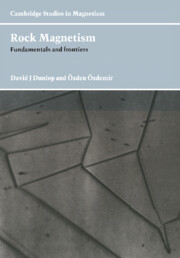Book contents
- Frontmatter
- Contents
- Preface
- Chapter 1 Magnetism in nature
- Chapter 2 Fundamentals of magnetism
- Chapter 3 Terrestrial magnetic minerals
- Chapter 4 Magnetostatic fields and energies
- Chapter 5 Elementary domain structures and hysteresis
- Chapter 6 Domain observations
- Chapter 7 Micromagnetic calculations
- Chapter 8 Single-domain thermoremanent magnetization
- Chapter 9 Multidomain thermoremanent magnetization
- Chapter 10 Viscous and thermoviscous magnetization
- Chapter 11 Isothermal magnetization and demagnetization
- Chapter 12 Pseudo-single-domain remanence
- Chapter 13 Crystallization remanent magnetization
- Chapter 14 Magnetism of igneous rocks and baked materials
- Chapter 15 Magnetism of sediments and sedimentary rocks
- Chapter 16 Magnetism of metamorphic rocks
- Chapter 17 Magnetism of extraterrestrial rocks
- References
- Index
Chapter 8 - Single-domain thermoremanent magnetization
Published online by Cambridge University Press: 06 July 2010
- Frontmatter
- Contents
- Preface
- Chapter 1 Magnetism in nature
- Chapter 2 Fundamentals of magnetism
- Chapter 3 Terrestrial magnetic minerals
- Chapter 4 Magnetostatic fields and energies
- Chapter 5 Elementary domain structures and hysteresis
- Chapter 6 Domain observations
- Chapter 7 Micromagnetic calculations
- Chapter 8 Single-domain thermoremanent magnetization
- Chapter 9 Multidomain thermoremanent magnetization
- Chapter 10 Viscous and thermoviscous magnetization
- Chapter 11 Isothermal magnetization and demagnetization
- Chapter 12 Pseudo-single-domain remanence
- Chapter 13 Crystallization remanent magnetization
- Chapter 14 Magnetism of igneous rocks and baked materials
- Chapter 15 Magnetism of sediments and sedimentary rocks
- Chapter 16 Magnetism of metamorphic rocks
- Chapter 17 Magnetism of extraterrestrial rocks
- References
- Index
Summary
Introduction
When magnetic minerals cool in a weak field H0 from above their Curie temperatures, they acquire thermoremanent magnetization (TRM) in the direction of H0 (or rarely, in the opposite direction) with an intensity proportional to H0. The fidelity of TRM in recording directions and intensities of ancient geomagnetic fields is the justification for paleomagnetism. TRM is the primary NRM of igneous rocks and some high-grade metamorphic rocks. The NRM of individual detrital grains in sediments and sedimentary rocks is frequently also a TRM inherited from the eroded source rocks.
TRM is much more intense than isothermal remanence (IRM) acquired in the same weak field H0 at room temperature. TRM is also very stable over long periods of time against changes in field (e.g., polarity reversals) or reheating. The reason for this high intensity and stability compared to room-temperature remanence is that TRM is acquired at high temperatures, where energy barriers and coercivities are low, and stabilized by cooling to ordinary temperatures, where barriers and coercivities are high.
TRM is a frozen-in high-temperature equilibrium distribution achieved by thermally excited transitions among different magnetic states (cf. §7.10). Transitions cease below the blocking temperature, TB, because in the course of cooling, the energy barriers Eb between different magnetization states grow larger than the available thermal energy (≈25kT for experimental times of a few minutes; ≈60kT for long geological times). In the last chapter, we discussed transdomain TRM, a partition between different domain structures governed by nucleation or denucleation of domains.
- Type
- Chapter
- Information
- Rock MagnetismFundamentals and Frontiers, pp. 201 - 233Publisher: Cambridge University PressPrint publication year: 1997



